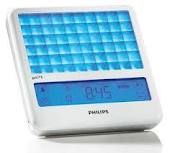It’s early October, and here in the UK there’s a distinct sense that the days are becoming ever-shorter and the nights are drawing in. This change in lighting condition can, for some, spell a distinct downturn in general levels or energy and wellbeing. Others can be prone to food cravings in the winter. Still others can suffer from full-blown depression (seasonal affective disorder).
Getting out in the sun (even on a relatively dull day) may help individuals maintain a brighter disposition, but the reality is some are still unable to get optimal amounts of light exposure (for them) with this tactic. Help is at hand, though, in the form of devices which provide light of a wavelength that seems to have the most impact on mood and energy (blue light). I’ve seen lots of people do very well with these devices, even through use in the morning amounting to no more than 10-15 minutes each day.
You can read about light therapy for seasonal affective disorder as well as another couple of approaches in a blog post I wrote a couple of years back.

Recently, though, I was interested to read an article about ‘bright light therapy’ (BLT) which focused not on its value in adults with seasonal affective disorder, but in other groups including children and adolescents, pregnant women, and individuals suffering from eating disorders. The authors of this review admit that the volume of research in these areas is significantly smaller than that concerning the use of bright light therapy in adult seasonal affective disorder, however there is at least enough research to suggest that this therapy has promise in these other groups.
The review is ‘open access’ which means anyone can read it for free. You can access the paper here. It might be of interest to health professionals, sufferers and loved ones of sufferers alike.
References:
1. Krysta K, et al. Bright light therapy in the treatment of childhood and adolescence depression, antepartum depression, and eating disorders. J Neural Transm. 2012;119(10):1167-72.